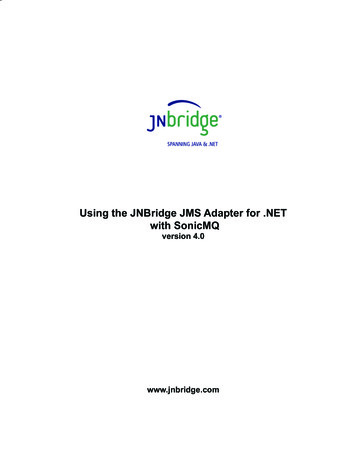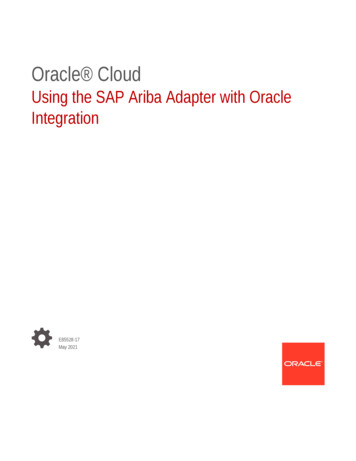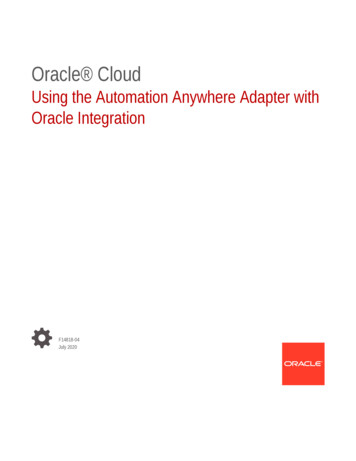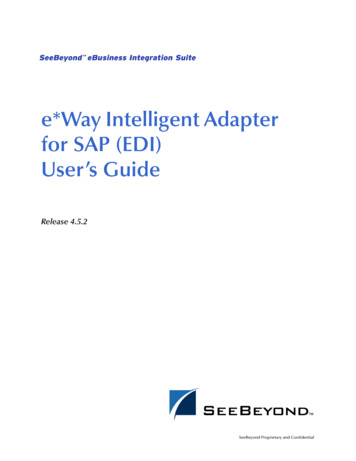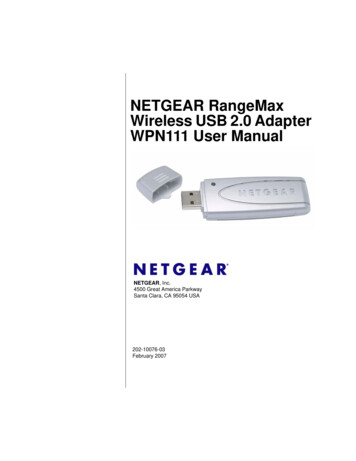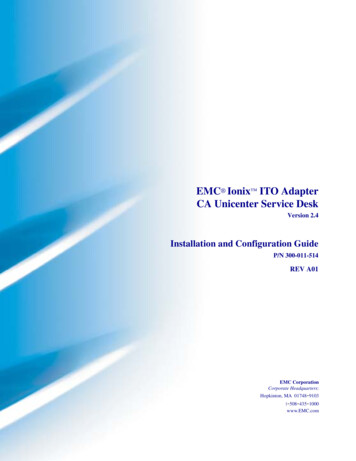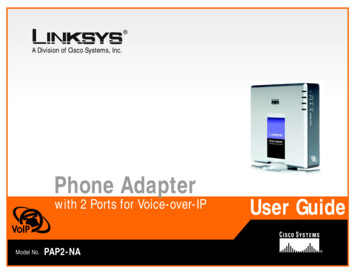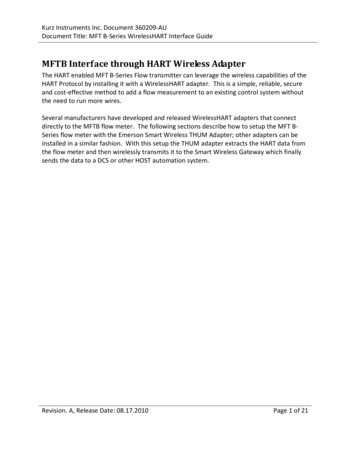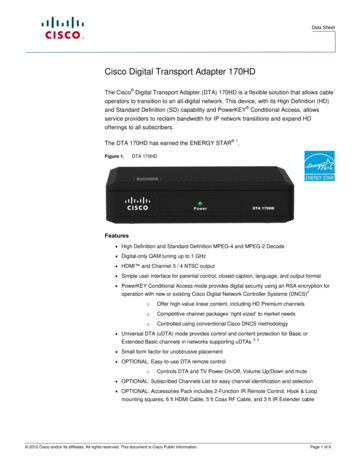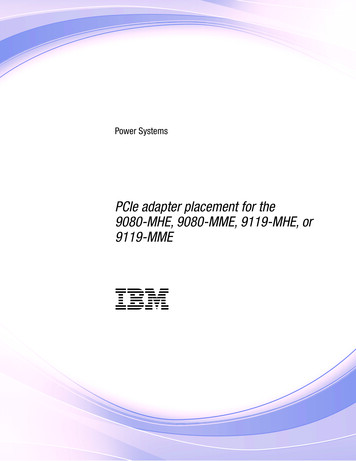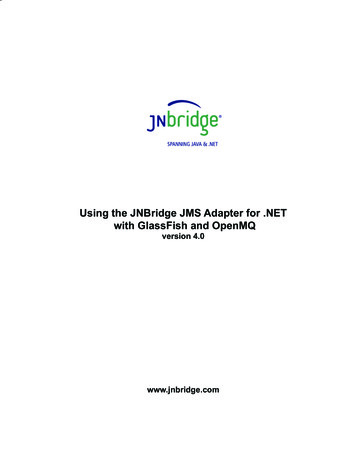
Transcription
Using the JNBridge JMS Adapter for .NETwith GlassFish and OpenMQversion 4.0www.jnbridge.com
Using the JMS Adapter with GlassFishJNBridge, LLCwww.jnbridge.comCOPYRIGHT 2008-2016 JNBridge, LLC. All rights reserved.JNBridge is a registered trademark and JNBridgePro and the JNBridge logo are trademarks of JNBridge, LLC.Oracle and Java are registered trademarks of Oracle and/or its affiliates.Microsoft, Windows, Windows Server, BizTalk and the Windows logo are trademarks, or registered trademarks ofMicrosoft Corporation in the United States and/or other countries.All other marks are the property of their respective owners.This product includes software developed by the Apache Software Foundation (http://www.apache.org/).2Version 4.0
Using the JMS Adapter with GlassFishContentsQuick Config for GlassFish/OpenMQ. 4Binding Properties Tab. 4URI Properties Tab. 4Using the JMS Adapter with GlassFish. 5Resources. 5Machine Prerequisites. 5Configuring the Adapter Connection Properties. 6Binding Properties Tab. 6JNBridge Properties Category. 7URI Properties Tab. 8Security Tab. 9Version 4.03
Using the JMS Adapter with GlassFishQuick Config for GlassFish/OpenMQBinding Properties Tab Initial Context Factory:For GlassFish 3.x and 4.x, use this initial context ontextFactoryFor GlassFish 2.1, use this initial context factory:com.sun.appserv.naming.S1ASCtxFactory JMS Scheme: iiop Queue Factory:No default connection factories are pre-configured. Topic Factory:No default connection factories are pre-configured. Class PathFor GlassFish 3.x and 4.x, Use this JAR file, gf-client.jar. Because this JAR file has anembedded classpath, it must be in situ with the entire GlassFish/OpenMQ directory structure.For GlassFish 2.1, use these JAR files (there is no embedded class path, so use only e.jar JVM Path (example)C:\Program Files\Java\jre7\bin\client\jvm.dll JVM ArgumentsIf the GlassFish server is not running on the machine where BizTalk and the adapter areinstalled, then a JEE system property must be used to specify the machine where theGlassFish server is running. Use the JVM Arguments property with this entry:-Dorg.omg.CORBA.ORBInitialHost servername URI Properties Tab Port Number: 37004Version 4.0
Using the JMS Adapter with GlassFishUsing the JMS Adapter with GlassFishThis document uses the example JMS service that comes pre-configured in GlassFish/OpenMQ. Thisdocument assumes some passing familiarity with enterprise Java such as JNDI contexts, factories andgeneral connection requirements and parameters. This document also assumes that the .NET developerhas access to particular information peculiar to the target JMS implementation. Finally, this documentassumes that the reader is knowledgeable and experienced with .NET.This document only discusses those property values that pertain to communicating with GlassFish. Otherproperties that are not discussed here can be found in the companion Using the JNBridge JMS Adapter for.NET document.Resources The user guide, JNBridge JMS Adapter for .NET Users’ Guide. Chances are, if the target GlassFish implementation is mature, the values for the configuration ofBizTalk transport handlers and send/receive ports can be supplied by the GlassFish administrator,gleaned from existing JMS client code or property files, e.g. jndi.properties. If the GlassFish/OpenMQ implementation targeted is not configured, then the default example JMSbroker can be used for proof-of-concept evaluations. It is strongly suggested that the developer read the section Tips and Tricks in the JNBridge JMSAdapter for .NET Users’ Guide.Machine PrerequisitesThe following prerequisites are needed for the adapter. A Java Run-time Environment (JRE) must be installed on the target machine. The JNBridge JMSAdapter supports the Standard Edition JRE 7 or above. GlassFish 3.x requires Java 6 or higher.GlassFish 4.x requires Java 7 or higher. The JNBridge JMS Adapter for BizTalk uses the stand-alone JMS environment supplied byGlassFish. This environment consists of one or more JAR files. Please see the section, Class Path,below.Version 4.05
Using the JMS Adapter with GlassFishConfiguring the Adapter Connection PropertiesThe Add Adapter Service Reference development tool in Visual Studio is used to generate theapp.config file and the WCF client file. The WCF client contains the methods chosen to send andreceive JMS messages. The app.config file contains the binding element whose attribute values are theparameters used to initialize and connect to the JMS server. Each of the binding attribute values can beentered in the Binding Properties tab of the Configure Adapter dialog box. While it is possible to enterthese values and then connect to the JMS server from the Add Adapter Service Reference dialog box, itis more efficient to work off-line and generate the app.config and the WCF client using only the genericoperations. Please see the section Tips and Tricks in the JNBridge JMS Adapter for .NET Users’ Guide formore information about working off-line and using the generic operations.Binding Properties TabThe JMS Properties category are properties used to properly connect to a JMS server. Choose JMS VendorThis is a drop-down control that comes pre-charged with default vendor connectionproperties. Click and select GlassFish and the default configuration values will automaticallyappear. Custom Connection StringThis is a text-editable field. This property is only used if the JMS implementation usescomplex URLs containing query expressions, or some proprietary connection string. that cannot be constructed from the Host Name and Port Number properties. If this property containsa value, then the Host and Port properties in the URI tab will be ignored. JMS Acknowledge ModeThe Acknowledge Mode is a drop-down list containing the JMS specification that determineshow a JMS client and server institute a reliable messaging protocol. The choices are AUTOACKNOWLEDGE, CLIENT ACKNOWLEDGE and DUPS OK ACKNOWLEDGE. Regardlessof the choice, the JNBridge JMS Adapter will correctly implement the protocol. For a defaultGlassFish connection factory, AUTO ACKNOWLEDGE is the default configuration. Initial Context FactoryThis is a text-editable field containing the name of the initial context factory. The initialcontext factory is a class used to create a JNDI initial context used to look-up connectionfactories and destinations. For GlassFish 3.x and 4.x, use this initial context ontextFactoryFor GlassFish 2.1, use this initial context ion 4.0
Using the JMS Adapter with GlassFish JMS SchemeThis is a text-editable field. The JMS Scheme or Protocol is particular to each vendor’s RMIimplementation. The protocol is part of the URI used to connect to the JMS service.For GlassFish, the scheme is:iiop JMS VersionThis property tells the adapter which JMS implementation to expect when it loads thevendor’s client stack—the JAR files in the Class Path property. The drop-down list containstwo choices, ‘JMS 1.1’ and ‘JMS 2.0’. JMS Security ModeThe JMS Security Mode is a drop-down list that specifies the type of security required by theJMS server implementation. The choices are none, simple and strong. If the choice is simple,then the server expects a user name and password.!If the JMS server implements simple security, it is not necessary to configure thisproperty. Enter a user name and password—the JNBridge JMS Adapter willautomatically switch to the simple security mode. Queue Connection FactoryThis is a text-editable field. No default connection factories are pre-configured.!This value includes the JNDI directory path to the connection factory. The completeJNDI path must be provided. Topic Connection FactoryThis is a text-editable field. No default connection factories are pre-configured.!This value includes the JNDI directory path to the connection factory. The completeJNDI path must be provided.JNBridge Properties CategoryThe JNBridge Properties Category correctly configure the .NET-to-Java interoperability core components. Class PathThe Java class path is a set of semicolon-separated paths to the JAR or class files required fora JMS client installation. The class path is used by the JNBridge Java to .NET interoperabilityVersion 4.07
Using the JMS Adapter with GlassFishcomponents to locate the JMS and JNDI client Java classes so they can be instanced in theJava Virtual Machine.To edit the class path, click in the field to enable the browse button. Click on the button tolaunch the Edit Class Path dialog. Note that only checked elements will be added to the classpath when the dialog is dismissed.For GlassFish version 3.x and 4.x, the jar file required by the JMS adapter:[GlassFish Directory]\glassfish\lib\gf-client.jarThis JAR file has an embedded classpath in its manifest. As such, it is recommended that themachine where BizTalk and the adapter are installed also have GlassFish installed even if theGlassFish server is running on another machine. The Class Path property must point to thegf-client.jar file in situ.For GlassFish 2.1, use these JAR files (there is no embedded class path, so use only e.jar JVM PathThe JVM Path property is the absolute path to the Java Virtual Machine implementation,jvm.dll. To edit the JVM Path property, click in the field to enable the browse button.Click on the button to launch the standard File Open dialog. Navigate to jvm.dll andclick OK. In the example shown, the JVM used is:C:\Program Files\Java\jre7\bin\client\jvm.dll JVM ArgumentsIf the GlassFish server is not running on the machine where BizTalk and the adapter areinstalled, then a JEE system property must be used to specify the machine where theGlassFish server is running. Use the JVM Arguments property with this entry:-Dorg.omg.CORBA.ORBInitialHost servername URI Properties TabThis category provides the location of the host where GlassFish is running and the port that GlassFishlistens to for connections. HostThe host name or IP address of the machine running GlassFish.8Version 4.0
Using the JMS Adapter with GlassFish PortThis is a text editable field. Enter the port where GlassFish is listening for client connections.By default this is port 3700.Security TabThis tab need only be used if security is implemented in the GlassFish server and is of type simple.Note that the password will appear in clear text in the app.config file. Please see the section DeployingSolutions in the Users’ Guide. Client credential typeThis is a drop-down control. Choose the credential type Username. User nameEnter the user name credential. PasswordEnter the password credentialVersion 4.09
To edit the class path, click in the field to enable the browse button. Click on the button to launch the Edit Class Path dialog. Note that only checked elements will be added to the class path when the dialog is dismissed. For GlassFish versi
